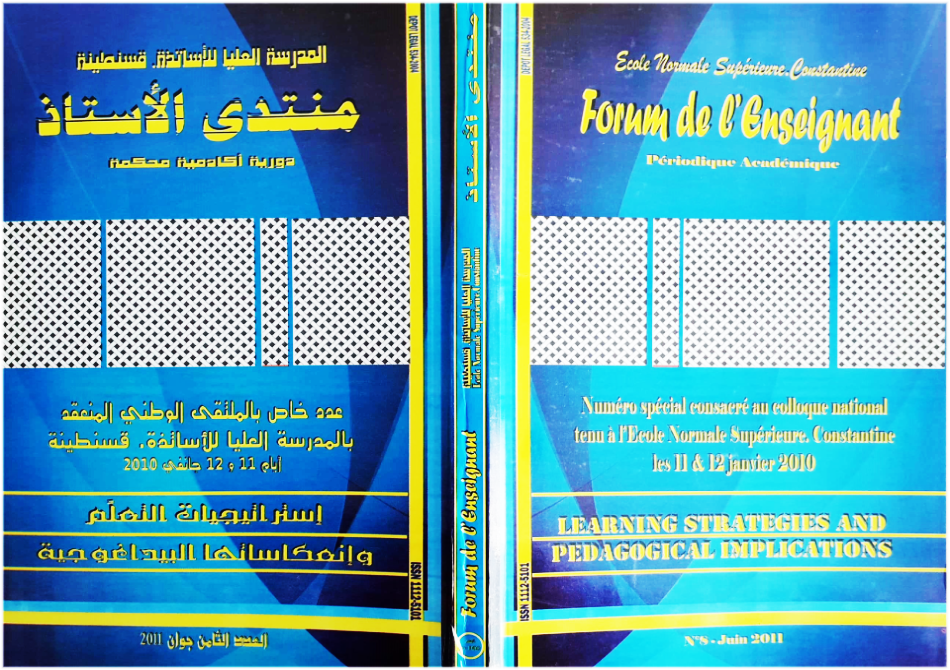فهم المتعلمين الناجحين
الكلمات المفتاحية:
استراتيجيات تعلم اللغة – المتعلمون الناجحون – الكفاءة في ممارسة الإنجليزية لغة أجنبيةالملخص
يتناول هذا البحث موضوع الفروق الفردية في
مجال تعلم اللغات، وهو موضوع معقد يتطلب
بحثا مستمرا، حيث أنه دراسة تم تطويرها
واستعمالها لتفحص الاستراتيجيات التي
يستعملها المتعلمون الناجحون الجزائيون خارج
فصل الدراسة وخارجه. توظف هذه الدراسة
أنواعا متعددة من المعطيات كالمقابلة
والاستبيان والمراسلات الإلكترونية في شكل
استراتيجية مثلثة لتعطي صورة تعبر عن ثراء
التجربة ومدى تعقيدها، حيث تنتهي النتائج
إلى مجموعة من استراتيجيات التعلم يمكن
تصنيفها في ثلاثة أنواع رئيسية: ماوراء عقلية
وعقلية وثقافية اجتماعية عاطفية.
التنزيلات
المراجع
Chamot, A. (1987). “The learning strategies of ESL students”. In A. Wenden and J.
Rubin (eds.), Learner Strategies in Language Learning (pp. 71–83). Englewood Cliffs, NJ:
Prentice-Hall.
Dörnyei, Z. (2008). The Psychology of the Language Learner: Individual differences in
second language acquisition. Lawrence Erlbaum Associates, Inc.
Dörnyei, Z. (2009). “Individual Differences: Interplay of Learner Characteristics and
Learning Environment”. Language Learning 59:Suppl. 1, December 2009, 230–248.
Ehrman, L.E, Leaver, B.L., Oxford, R.L. (2003). “A brief overview of individual
differences in second language learning”. System 31, 313–330.
Ellis, R. (2004). “Individual differences in second language learning”, in A. Davies &
C. Elder (eds), Handbook of Applied Linguistics. (pp. 525-551). Black Publishing
Limited.
Horwitz, E. K. (2001). “Language anxiety and achievement”. Annual Review of Applied
Linguistics, 21, 112-126.
Hsiao, T.Y., & Oxford, R. L. (2002). Comparing theories of language learning
strategies: A confirmatory factor analysis. Modern Language Journal, 86(3), 368–383.
Inbar, O., Donitsa-Schmidt, S., & Shohamy, E. (2001). “Students’ motivation as a
function of language learning: The teaching of Arabic in Israel”. In Z. Dörnyei & R.
Schmidt (Eds.), Motivation and Second Language Acquisition (pp. 297–311). Honolulu,
HI: University of Hawaii Press.
Kinsella, K. (1995). “Understanding and empowering diverse learners in ESL
classrooms”. In J. Reid (Ed.), Learning styles in the ESL/EFL classroom (pp. 170–194).
Boston: Heinle & Heinle.
Naiman, N., Fröhlich, H., Stern, H., & Todesco, A. (1995 [1978]). The Good Language
Learner. Clevedon, UK: Multilingual Matters.
O’Malley, J. & Chamot, A. (1990) Learning Strategies in Second Language Acquisition.
Cambridge: Cambridge University Press.
Oxford, R. (1990). Language Learning Strategies: What every teacher should know.
Rowley, MA: Newbury House.
Oxford, R. L., & Anderson, N. J. (1995). “A crosscultural view of learning styles”.
Language Teaching, 28, 201–215.
Oxford, R. L., Ehrman, M. E., & Lavine, R. Z. (1991). ““Style wars”: Teacher student
style conflicts in the language classroom”. In S. Magnan (Ed.), Challenges in the 1990s
for college foreign language programs (pp. 1–25). Boston MA: Heinle & Heinle.
Oxford, R., Hollaway, M.E., & Horton-Murillot, D., 1992. “Language Learning Styles:
Research and Practical Considerations for Teaching in the Multi-Cultural Tertiary
ESL/EFL Classroom”. System, Vol. 20 N°4, 439-456.
Pintrich, P. R., Smith, D. A. F., Garcia, T., & McKeachie, W. J. (1993). “Reliability and
predictive validity of the motivated strategies for learning questionnaire (MLSQ)”.
Educational and Psychological Measurement, 53, 801–813.
Pintrich, P. R., Smith, D. A. F., Garcia, T., & McKeachie, W. J. (1991). A manual for the
use of the Motivated Strategies for Learning Questionnaire (MSLQ). Ann Arbor:
NCRIPTAL, School of Education, University of Michigan.
Rubin, J. 1975. “What the good language learner can teach us”. TESOL Quarterly 9, pp
-51.
Skehan, P. (1989). Individual Differences in Second-Language Learning. London: Edward
Arnold.
Stern, H.H. (1975). What can we learn from the good language learner? Canadian
Modern Language Review, 31, 304-318.
Stern, H.H., 1983. Fundamental Concepts in Language Teaching. Oxford: Oxford
University Press.
Ushioda, E. (2009). “A person-in-context relational view of emergent motivation and
identity”. In Z. Dörnyei & E. Ushioda (Eds.), Motivation, language identity and the L2
self (pp. 215–228). Bristol, UK: Multilingual Matters.
Vann, R., & Abraham, R. (1990). “Strategies of unsuccessful language learners”.
TESOL Quarterly, 24(2), 177-198.
Warr, P. & Downing, J. (2000). “Learning strategies, learning anxiety, and knowledge
acquisition”. British Journal of Psychology, 91, 311-333.
Weinstein, C. E., Schulte, A. C., & Palmer, D. R. (1987). LASSI: Learning and study
strategies inventory. Clearwater, FL: H & H Publishing.
Zimmerman, B. J., & Martinez-Pons, M. (1986). « Development of a structured
interview for assessing students’ use of self-regulated learning strategies”. American
Educational Research Journal, 23, 614–628.
Zimmerman, B. J., Martinez Pons, M. (1988). « Construct validation of a strategy
model of student self-regulated learning”. Journal of Educational Psychology, 80, 284–290.





